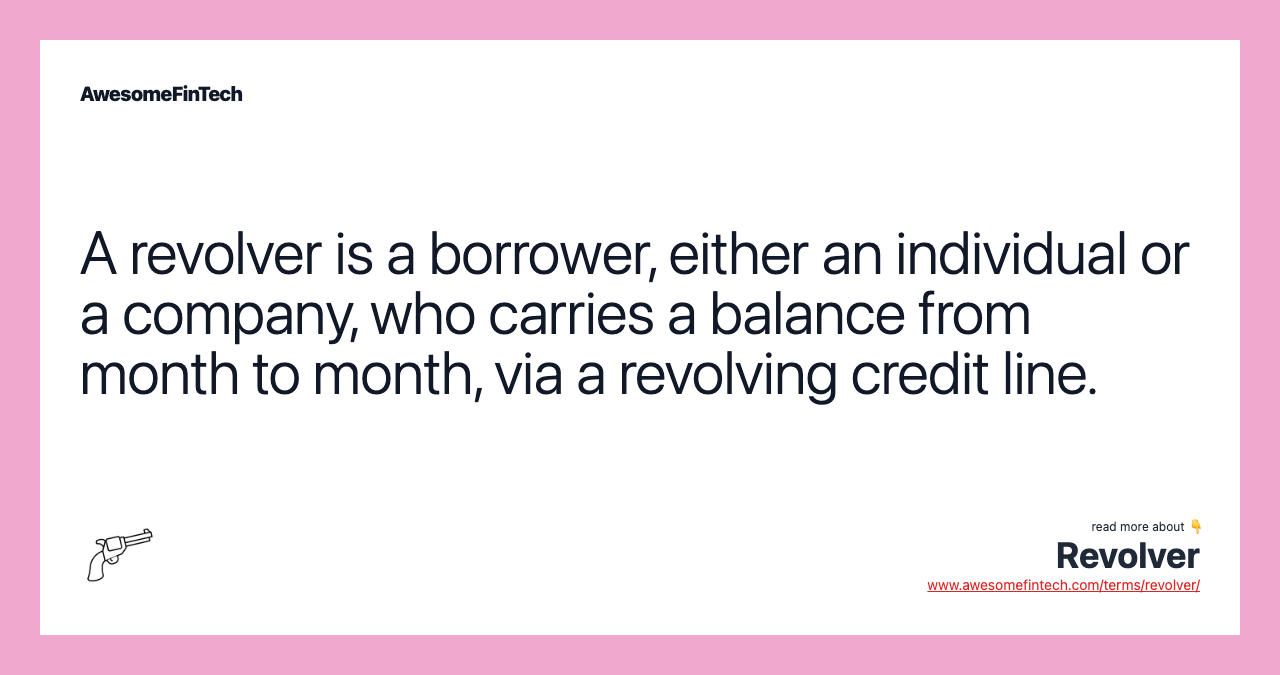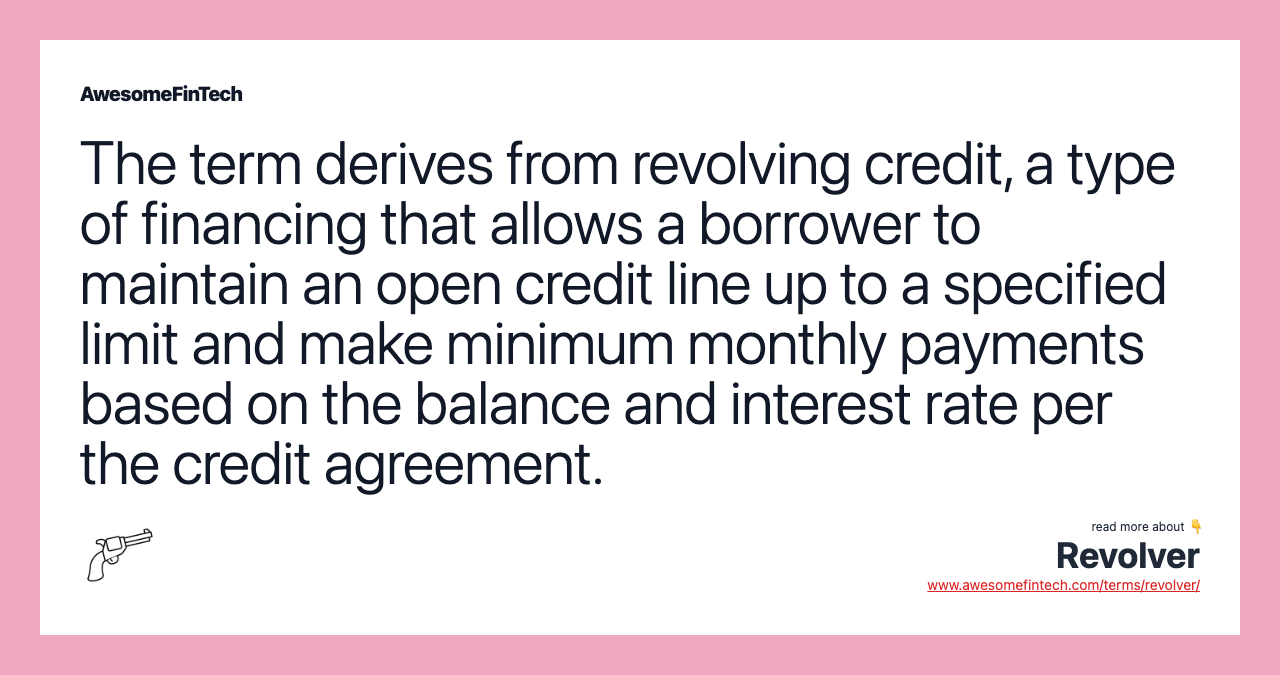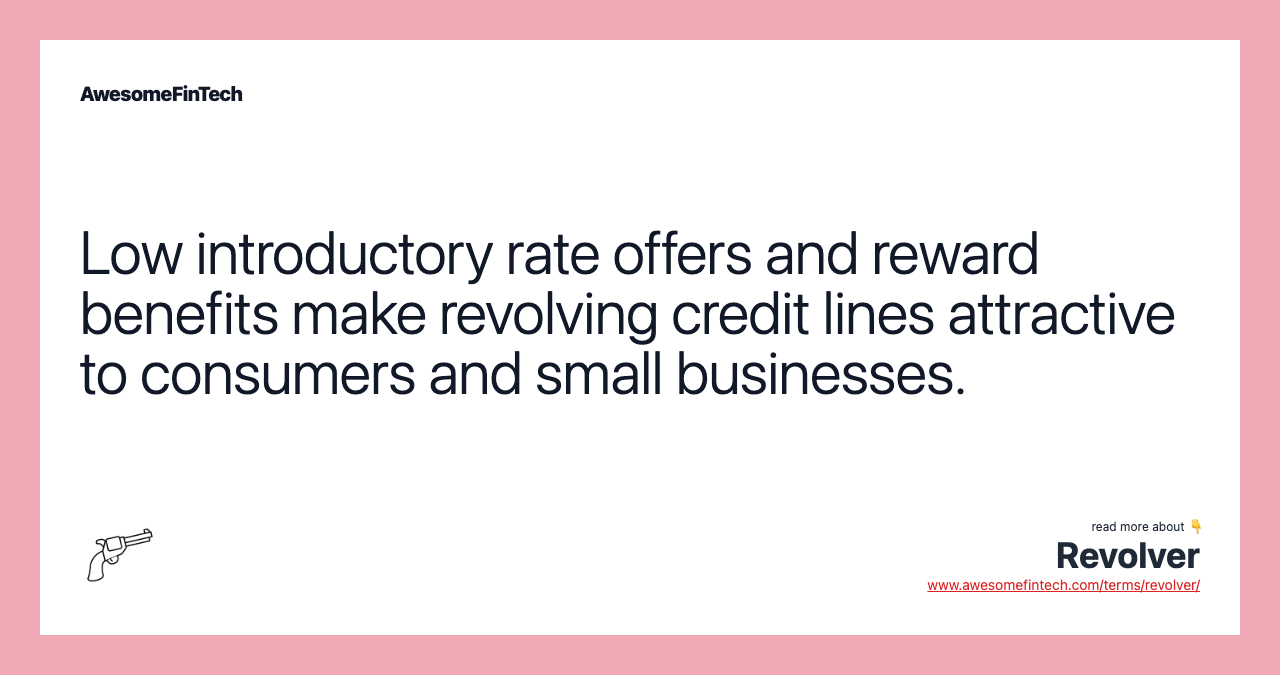Revolver
A revolver refers to a borrower — either an individual or a company — who carries a balance from month to month, via a revolving credit line. A revolver lets an individual consumer or a business open a line of credit through a credit card or line of credit bank account, where the credit issuer offers a specified level of credit over time. The term derives from revolving credit, a type of financing that allows a borrower to maintain an open credit line up to a specified limit and make minimum monthly payments based on the balance and interest rate per the credit agreement. A borrower approved for a revolving credit line can keep the credit line open for an undefined period of time, as long as they remain in good standing with the credit issuer. While the underwriting approval standards are typically the same for both revolving and non-revolving credit, revolving credit lines usually involve a more simplified application process.

What Is a Revolver?
A revolver refers to a borrower — either an individual or a company — who carries a balance from month to month, via a revolving credit line. Borrowers are only obligated to make minimum monthly payments, which go toward paying interest and reducing principal debt. Revolvers are used in finance by corporations to fund working capital needs, which are expenses for day-to-day operations such as payroll.
A revolver can sometimes be referred to as a revolver loan or revolving debt. However, revolver loans are usually fixed-rate credit products and are synonymous with business loans. A revolving credit line typically comes with a variable interest rate set by a bank, meaning it can fluctuate with market conditions.




Understanding Revolvers
The term revolver comes from revolving credit_,_ a category of financing or borrowing. A revolver lets an individual consumer or a business open a line of credit through a credit card or line of credit bank account, where the credit issuer offers a specified level of credit over time. Credit issuers tend to profit handsomely from revolvers because the open-ended credit line means companies use them frequently and keep them in use for extended periods of time.
Revolving Debt Versus Non-Revolving Debt
Revolving and non-revolving credit lines each have distinct advantages. Revolving financing allows the borrower to maintain an open credit line up to a specified limit. Non-revolving financing involves a loan whereby a one-time payout is issued to the borrower who must, in turn, make fixed payments according to a schedule. Revolver financing doesn't involve fixed payments or coupon payments. Instead, a minimum monthly payment is due based on the balance and interest rate according to the terms of the credit agreement.
$1.065 trillion
The total amount of outstanding revolving debt in the United States as of January 2020, according to a Federal Reserve report.
Source: Federal Reserve.
Non-revolving credit loans are often obtained both by businesses seeking capital with which to finance new projects, and by consumers looking to buy homes, cars, and other big-ticket items. While the underwriting approval standards are typically the same for both revolving and non-revolving credit, revolving credit lines usually involve a more simplified application process.
The emergence of fintech technologies has dramatically increased the availability of both revolving and non-revolving credit products, providing greater access to credit to underbanked populations. Consumers in the market for non-revolving loans may now choose from independent lenders such as Lending Club or Prosper.
Special Considerations: Revolving Credit Payments
Consumers and small businesses are drawn to revolving credit due to low introductory rate offers and reward benefits. Furthermore, when borrowers make a payment, it reduces their outstanding debt balance and makes more money available for future borrowing. A borrower approved for a revolving credit line can keep the credit line open for an undefined period of time, as long as they remain in good standing with the credit issuer.
Related terms:
Available Credit
Available credit refers to how much a borrower has left to spend. This amount can be calculated by subtracting the borrower's purchases from the total credit limit on the account. read more
Average Outstanding Balance
An average outstanding balance is the unpaid, interest-bearing balance of a loan or loan portfolio averaged over a period of time, usually one month. read more
Charge-Off Rate (Credit Card)
A credit card charge-off rate is a measurement that shows the amount of defaulted credit card balances in comparison with the total amount of credit extended. read more
Consumer Credit
Consumer credit is personal debt taken on to purchase goods and services. Credit may be extended as an installment loan or a revolving line of credit. read more
Credit Agreement
A credit agreement is a legally-binding contract that documents the terms of a loan agreement. It outlines the details of the loan and its clauses. read more
Debt Avalanche
A debt avalanche is an accelerated system of paying down debt that is based on paying the loan with the highest interest rate first. read more
Debt
Debt is an amount of money borrowed by one party from another, often for making large purchases that they could not afford under normal circumstances. read more
Debt-to-Income (DTI) Ratio & Formula
Debt-to-income (DTI) ratio is the percentage of your gross monthly income that is used to pay your monthly debt and determines your borrowing risk. read more
Evergreen Loan
An evergreen loan, also known as a “standing” or “revolving” loan, is a loan that does not require principal to be paid within a specified period of time. read more
Financial Technology (Fintech)
Fintech, a portmanteau of 'financial technology,' is used describe new tech that seeks to improve and automate the delivery and use of financial services. read more